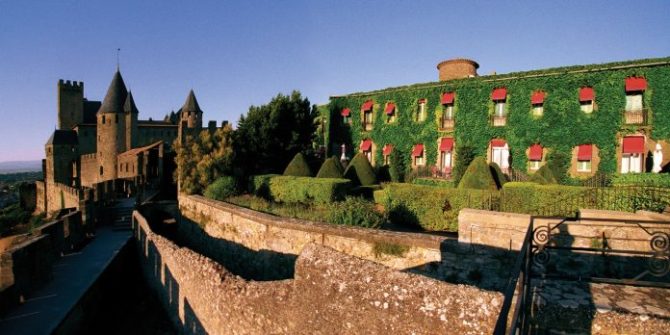Cook Like a ‘Bonne Femme’ to Celebrate Spring
Alors, le printemps est arrivé! Yet my favorite French author, Colette, often warned of “those deceptive spring days” that start out promisingly warm until a sudden bout of chilly wind and rain whips up out of nowhere and sends you scurrying home, seeking the warm glow of your kitchen. It seems that this year especially we can all use a little extra nourishment and comfort. Time to cook à la bonne femme.
In France, cooking like “a good woman” evokes soul-soothing, simmering soups, stews and other homey meals inventively devised from inexpensive ingredients or leftovers. I think of my grandmother’s sturdy, old-fashioned black stove which she used all her life, from which wafted the most mysterious and enticing scents. Nowadays I have Proustian moments whenever I taste just-grated cheese or freshly chopped parsley. It sends me right back to grandma’s red-and-white kitchen, where my mother and aunts sat round the table gossiping as they sorted peas or string beans together.
I learned even more about la bonne femme while I researched my novel, Cooking for Picasso: A Novel,interviewing Michelin-starred chefs in their restaurant kitchens on the French Riviera. Over their big simmering pots of food I soon discovered that every chef worth his salt claims that he got his passion for cooking by watching his talented maman or wise grand-mère. Even the most sophisticated chefs’ eyes invariably mist over at the thought of those warmhearted women in their cozy kitchens.
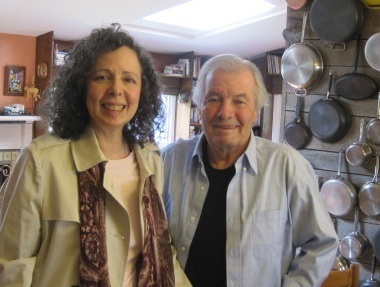
Author Camille Aubray with chef Jacques Pépin at home in his kitchen. ©Camille Aubray
Here in the States, I visited Jacques Pépin—once the personal chef to Charles de Gaulle—in his home kitchen. Amidst his favorite pots and pans, we talked about French cooking. He told me that my novel made him homesick for his mother’s coq au vin. No matter what the recipe, chefs agree that there is one crucial ingredient for cooking a meal made à la bonne femme: love.
So, in honor of all the world’s bonnes femmes, I offer you one of my own favorite thrifty recipes—what I call “Chicken 3-2-1” —featuring three different dinners, for two people, all made from one bird, which you can cook in a single session. Eat one dinner tonight, and freeze the other two, where they will be ready and waiting the next time you rush home on a damp spring eve, wishing for something quick and nourishing to eat. It’s easy!
The Recipe for Aubray’s Bonne Femme Poulet Trois-Deux-Un:
First, buy a whole chicken, never-frozen and preferably organic, about 3-5 pounds. You can have the butcher cut it up for you but frankly this is worth doing yourself. Just follow the bone structure of your bird, and cut two sets of legs/thighs, then a pair of wings, and two boneless chicken cutlets. Don’t worry if you’ve left some meat behind on the carcass: this will make your third meal—a hearty soup! When I am feeling ambitious and/or health-conscious, I also remove the skins, but that’s optional. Either way, be sure to rinse well and pat dry with paper towels. Now for your three meals!
Baked Chicken Legs à la Maman:
Coat the inside of a heavy rectangular baking dish generously with olive oil, place the leg/thighs and wings in it, turn them over in the oil until bathed on all sides, ending with the bone side down. Sprinkle with lemon juice, freshly grated black pepper, and whatever herbs you have in your kitchen. I use fresh thyme sprigs, or rosemary; or if nothing fresh is available, I use my favorite mix of dried herbes de provence. Put this into the oven at 375 degrees. Depending on the size of the bird, this will be done in 45-60 minutes. Check on it, and if it needs a little moisture, briefly remove the pan and add a splash of white wine around, but not on, the chicken, then return to the oven.
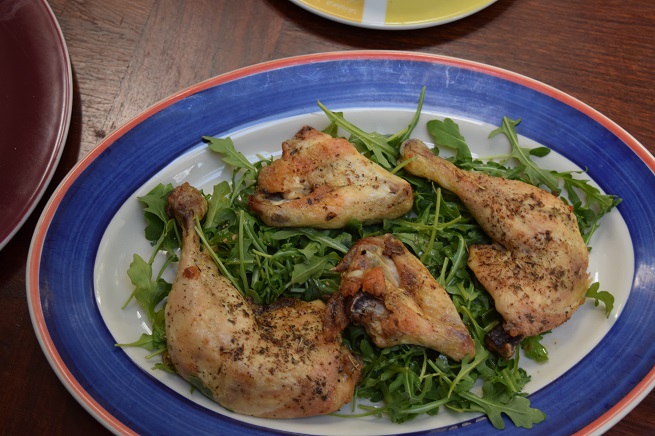
Aubray’s Chicken Legs à la Maman. ©Camille Aubray
If you want to freeze this, wrap it in foil and cool overnight. The next day put it in a freezer bag and freeze. On the day that you plan to eat it, thaw completely and pop a pair of potatoes in the oven (or steam on stovetop) and butter when done. The chicken can be served as is, or you can heat 4 tablespoons of olive oil in a heavy pan, and when the oil is hot, quickly crisp both sides of the meat for what I call a faux confit. Lay the chicken pieces on a bed of arugula or lettuce that’s been dressed with a quick whisk of lemon juice, olive oil and a dot of Dijon mustard. Salt to taste, and sprinkle with chopped scallions if available. Serve with a favorite red wine, like burgundy.
Soothing Chicken Soup à la Grand-Mère:
Meanwhile, on the same day that you’re baking the chicken legs, remember those carcass bones that were leftover when you cut up your chicken? Put the carcass in a stock pot, toss in 1 onion, 2 or 3 carrots, same amount of celery (all coarsely chopped), one slightly crushed garlic clove if you like, a bay leaf, and big sprigs of parsley, stems and all. Add lots of freshly grated pepper, and cold water to cover (about six cups). Bring to a boil and simmer 30-50 minutes or until the chicken on the carcass is thoroughly cooked. With tongs or a slotted spoon, remove the meat & bones to a plate. Strain out the vegetables and discard them, and allow the soup to cool. Wrap the carcass meat in foil, and wait until it’s completely cooled to put it in the refrigerator. Put the cooled soup into a smaller pot with a lid, and refrigerate overnight.
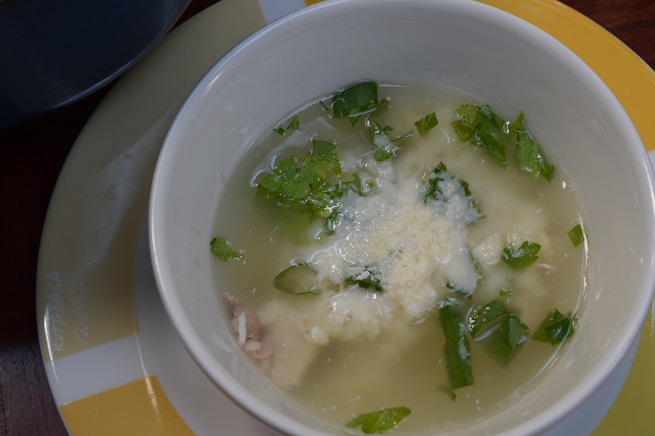
Aubray’s Chicken Soup à la Grand-Mère. ©Camille Aubray
The next day, skim the fat from the soup. Pull the chicken meat from the bones, cut into bite-sized bits and return to the soup. You can freeze this, to have when you’re hungry for a late-night supper or quick lunch; then, as the soup is slowly reheating, chop more carrots and celery very finely, the size of a baby’s teeth, and when the soup comes to a boil, toss in your new vegetables. Salt to taste, and if you have any leftover cooked rice, pasta, pastina or other grain, you can also add this to the soup when it’s come back to a second boil. If you don’t have any cooked leftover grains, make some toast triangles to float atop the soup after you ladle it into soup bowls. Sprinkle with chopped chives or scallions, and my favorite finale—freshly, finely grated parmesan cheese and/or shredded gruyere cheese. Serve with a salad in a whisked dressing of olive oil and sherry or wine vinegar; and into your salad you can add any canned beans like chick peas, and some olives, or some nuts, sliced fresh fruit and raisins. A good sherry or Madeira is great to drink here, or any favorite white wine.
Chicken Ondine (named after the heroine of my novel):
On that same first day when your soup is cooking and the chicken legs are baking, make this third, romantic meal. This is the one I usually serve on the day it’s cooked, but if you make enough sauce then it, too, can be frozen.
Place your boneless chicken cutlets between sheets of unbleached kitchen paper. Using a meat pounder (or if you don’t have one, use the back of a pan) to pound the cutlets flat and tender. Sprinkle them with a little salt and freshly ground pepper. Put two tablespoons of sweet (unsalted) butter into a pre-heated heavy pan, let the butter foam but not brown, and lay the cutlets in. Cook at medium-high heat, browning on both sides. When the chicken is truly browned all over and cooked through, transfer to a heated plate. While it’s browning, slice a shallot (or a small sweet onion if shallots are unavailable) and when you take the chicken out of the pan, keep the pan on the heat and put in the chopped shallot, scraping the pan as it softens so you pick up the browned bits, adding a bit more butter only if necessary. Take a cup of inexpensive brut champagne or sparkling wine (or a dry white or rosé wine) and add to the cooked shallot, turning up the heat to reduce the wine a bit; and add any juices that have come out of the “resting” chicken. Then add a half-cup of cream (or chicken stock if you don’t have cream) and a fresh herb (I prefer thyme but parsley is fine) and heat to thicken but do not boil. Now “finish it” by added another tablespoon of butter while it’s still on the heat, stirring rapidly until the sauce becomes silky. Add a bit of salt to taste, and pour the sauce over the chicken cutlets.
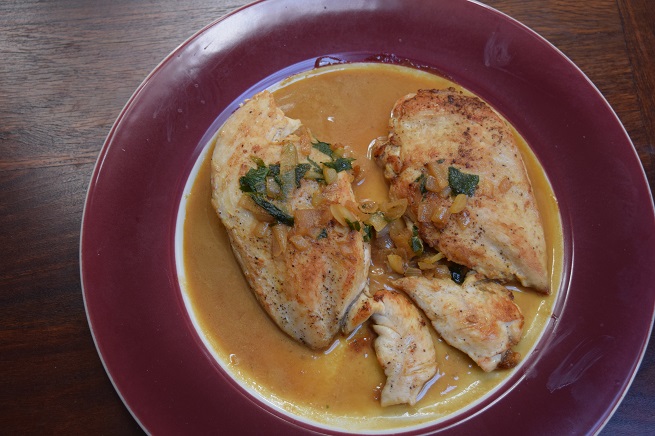
Aubray’s Chicken Ondine. ©Camille Aubray
You can serve the chicken cutlets on a bed of very thin pasta like capellini, or linguine or spaghetti, rice or other grain; or alongside yams or sweet potatoes that can be baked or steamed ahead while you were cooking. A green vegetable—spinach, chard, peas or green beans—is nice here, blanched in boiling water and then drained and seasoned with black pepper and butter or olive oil; but a salad is fine here as your vegetable, in a dressing made with olive oil and lemon juice that’s been whisked until creamy. A glass of dry champagne, or rosé, or chablis is excellent for this dinner.
There you are! Three meals à deux from one bird! It’s fun to cook this with a mate or friend, sipping wine, exchanging dreams and plans; or, present it to your Mom or Grandmother for a nice Sunday dinner. Whomever you share it with, fondly make a toast to the “good women” who modestly made memories for us all.

Author Camille Aubray.
©Camille Aubray
Camille Aubray is the author of the novel “Cooking for Picasso” (Penguin Random House) which was a People Magazine Pick for “Best New Books”. The paperback comes out on June 20th.
Camille’s book is available on Amazon below.
Share to: Facebook Twitter LinkedIn Email
Leave a reply
Your email address will not be published. Required fields are marked *

